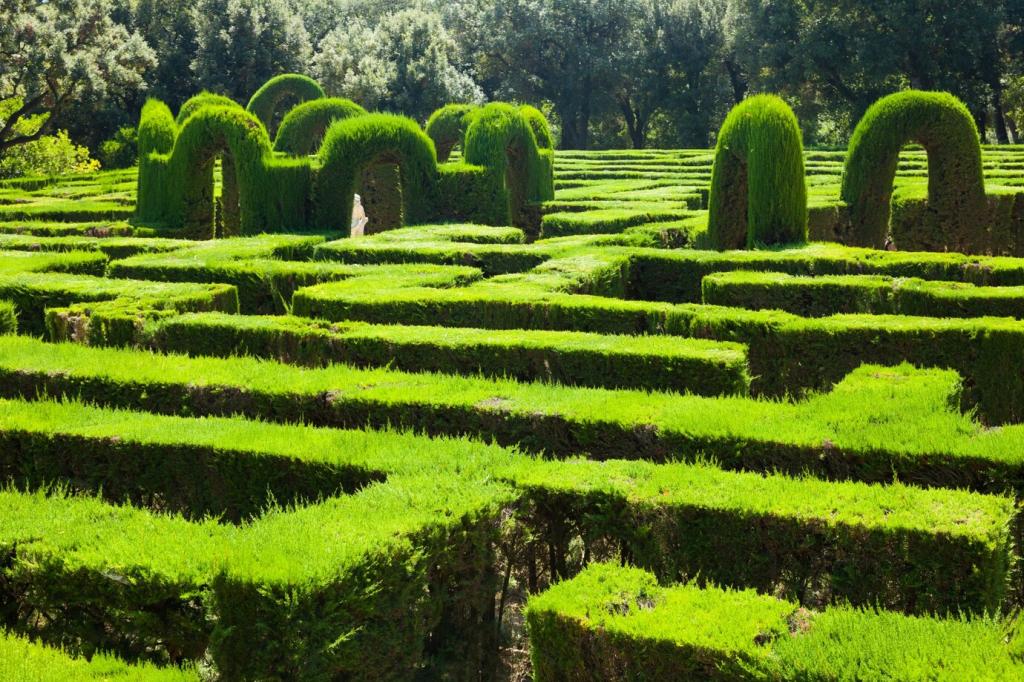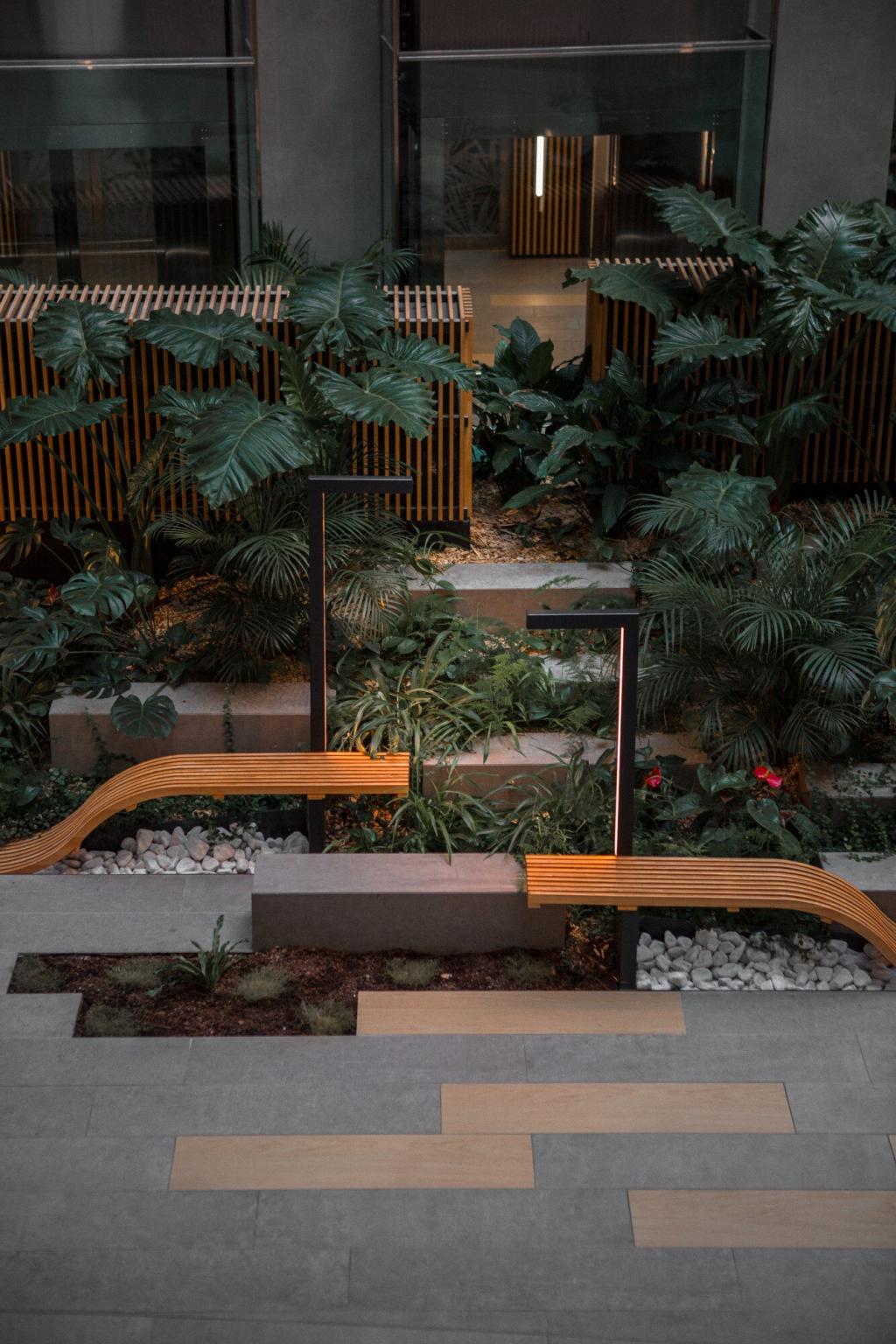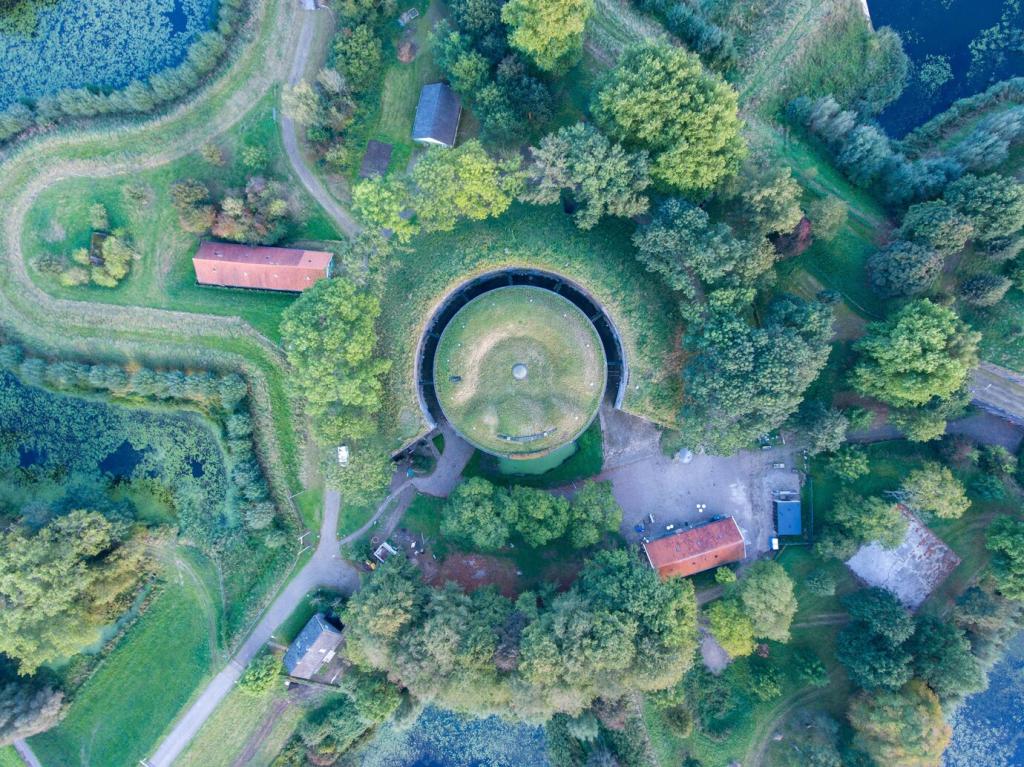Eco-Friendly Techniques in Urban Garden Design
Urban gardening has emerged as a vibrant response to environmental challenges posed by city living. By integrating eco-friendly techniques into urban garden design, homeowners, communities, and city planners can contribute to a healthier ecosystem while enhancing the quality of urban life. This page explores innovative, sustainable solutions that transform concrete landscapes into thriving, green sanctuaries right in the heart of the city. Through mindful planning and smart technologies, these techniques drive a new wave of urban renewal, shaping modern parks, courtyards, balconies, and rooftops into flourishing oases that benefit both people and the planet.
Previous slide
Next slide

Water Conservation Strategies
Rainwater Harvesting
Rainwater harvesting harnesses the natural cycle of precipitation by capturing runoff from roofs or impermeable surfaces and storing it in barrels or cisterns. In urban areas, where rainfall often escapes through storm drains, this strategy turns an overlooked resource into a sustainable water supply for gardens. Rainwater is typically softer and less treated than municipal supplies, offering plants better hydration. Incorporating collection systems into garden design ensures that even small urban plots remain hydrated with minimal dependence on city water.
Drip Irrigation Systems
Drip irrigation introduces water directly to the plant’s root zone via a network of emitters and hoses, maximizing efficiency and minimizing waste. Unlike traditional sprinklers, which lose water due to evaporation and runoff, drip systems deliver steady moisture exactly where it’s needed. For city gardens with restricted space and resources, these systems are invaluable, as they can be precisely controlled to match the needs of a diverse plant palette. Over time, drip irrigation reduces water use and supports healthier, deeper-rooted plants that are better equipped to handle urban stressors.
Permeable Surface Integration
Replacing impermeable pavements with permeable alternatives dramatically enhances a garden’s ability to absorb and utilize rainfall. Permeable surfaces—such as gravel, permeable pavers, or stabilized soil—allow water to percolate through the ground rather than draining away. This technique not only sustains plantings by supplying critical soil moisture, but also helps control urban flooding and recharge local aquifers. Within tight urban corridors and courtyards, utilizing these surfaces ensures every drop of rain helps nourish plants and cool the city.
Biodiversity Enhancement
Native Plant Selection
Cultivating gardens with native plants encourages robust, low-maintenance landscapes naturally adapted to regional conditions. Native species are best equipped to thrive in local soils and climate, requiring less supplemental water and fertilizer. Additionally, they provide crucial habitat and food for indigenous pollinators and birds, strengthening ecological networks amid urban sprawl. Designing urban gardens with a high proportion of native species reinforces their sustainability, fosters biodiversity, and creates a stronger sense of place.
Pollinator Habitat Creation
Urban environments often lack adequate resources for pollinators such as bees, butterflies, and hummingbirds. Intentionally planting a mixture of flowering species that bloom throughout the growing season provides a continuous supply of nectar and pollen. Features like bee hotels, undisturbed ground for nesting, and water stations further transform gardens into vital waypoints for these essential creatures. By supporting pollinator populations, city gardens ensure productive harvests while contributing to the wider health of urban ecosystems.
Multi-Layered Planting
Strategically establishing varied plant layers—from ground covers to shrubs and tree canopies—mimics the natural complexity of wild habitats. This vertical diversity not only maximizes the use of limited space, but also offers homes to a wide range of species. In urban gardens, multi-layered plantings regulate microclimates, reduce soil erosion, and decrease pest outbreaks by supporting complex food webs. These living mosaics provide ever-changing interest through the seasons and reinforce the ecological role of urban greenery.

Recycled Wood and Composite Lumber
Old pallets, reclaimed beams, and other forms of recycled wood offer sturdy, character-rich options for raised beds, garden structures, and furnishings. Where wood cannot be sourced locally or sustainably, composite lumber made from recycled plastics provides a maintenance-free, long-lived alternative. Using these materials diverts waste from landfills, lessens demand for virgin timber, and ensures that garden features are both durable and eco-responsible. The warm patina and adaptability of recycled materials also enhance the personality and story of urban gardens.

Reused Containers and Planters
Urban constraints often call for creative solutions—repurposing containers such as buckets, crates, or even old bathtubs into planters saves money and resources. These items, otherwise destined for the waste stream, can support robust displays of flowers, herbs, or vegetables. By cleaning and adapting reused containers to ensure drainage and suitability for plants, city gardeners exemplify ingenuity and commitment to sustainability. Reused containers add eclectic charm and adapt to tight or irregular urban spaces with ease.

Soil Moisture Sensors
Soil moisture sensors take the guesswork out of irrigation, triggering watering systems only when plants truly need it. These devices monitor soil conditions in real time, ensuring that plants never suffer from drought or excess moisture. By avoiding overwatering, urban gardeners reduce water waste and prevent nutrient runoff. Integrating soil sensors into urban landscapes brings smart precision to gardening, supporting optimal plant health and promoting the wise use of city resources.

Automated Drip and Sprinkler Controls
Modern irrigation systems can be automated and adjusted through smartphone apps or standalone timers, adapting to weather forecasts and plant requirements. This ensures that gardens are watered at the ideal intervals, even when owners are away or during changing seasonal conditions. Automation minimizes labor, maximizes consistency, and conserves water, making it especially valuable in the fast-paced urban setting. Over time, these intelligent controls help urban gardens deliver lush results while meeting conservation commitments.

Solar-Powered Lighting and Devices
Solar technology has become increasingly accessible, offering an eco-friendly power solution for garden lighting, pumps, and decorative features. Powered by renewable energy, solar lights illuminate gardens at night without contributing to carbon emissions or adding to electricity bills. Solar charges are also used to power smart sensors, electric fencing, or water features. Integrating solar-powered devices supports the broader shift toward renewable energy use in cities and extends the enjoyment and functionality of urban gardens well after the sun sets.
Urban Microclimate Moderation
Green roofs transform barren rooftops into vibrant landscapes, providing insulation that reduces building energy consumption and mitigates the urban heat island effect. Living walls, whether interior or exterior, increase green coverage vertically, improving air quality by filtering particulates and producing oxygen. Both systems act as habitats for insects and birds, contribute to stormwater management, and insulate buildings from temperature extremes. Integrating green roofs and walls into urban design has proven one of the most visually striking and ecologically impactful interventions in city environments.

Vertical Vegetable Gardens
Vertical vegetable gardens maximize productivity in minimal spaces, stacking planters or using trellises to grow leafy greens, tomatoes, or beans upwards instead of outwards. This approach is particularly suitable in cities where ground space comes at a premium. With clever irrigation and rich soil, vertical systems support diverse crops while facilitating easy access for harvesting. Urban dwellers enjoy the benefits of fresh, nutritious produce grown steps from their kitchens, thus shrinking their ecological footprint and deepening their connection to food sources.
Culinary and Medicinal Herb Borders
Designing borders or raised beds dedicated to herbs provides a dual benefit: aesthetic interest and a steady supply of fresh flavorings or health-boosting plants. Herbs like basil, thyme, and mint thrive in containers or small patches and can be harvested repeatedly throughout the season. Similarly, growing medicinal varieties such as chamomile or calendula supports home remedy traditions while attracting pollinators. These multifunctional plantings empower urban gardeners to reclaim a measure of independence and well-being, anchored in their immediate environment.
Fruit Trees and Berry Bushes
Introducing dwarf or espaliered fruit trees and berry bushes into urban gardens brings seasonal bounty with minimal space requirements. Choose varieties suited to containers or limited soils, and enjoy harvests of apples, figs, strawberries, or currants. Besides providing fresh produce, these plants contribute to biodiversity, support pollinators, and offer pockets of shade. Edible plantings inspire a neighborhood culture of sharing, education, and appreciation for the cycles of growth and renewal, embedding the garden more deeply within its urban community.
